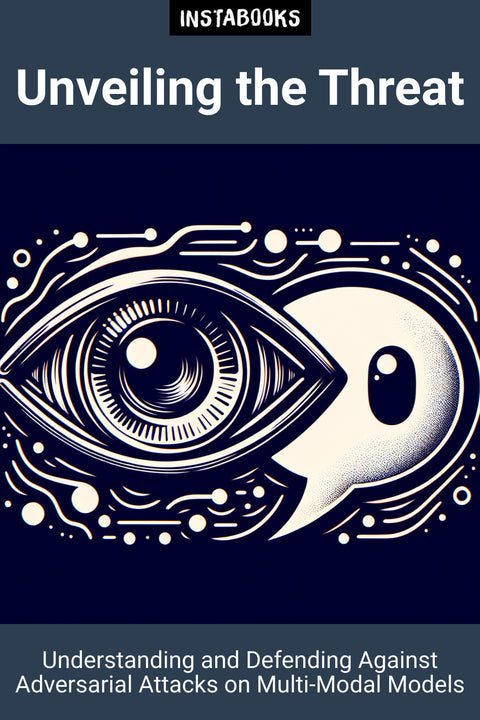
Unveiling the Threat
Understanding and Defending Against Adversarial Attacks on Multi-Modal Models
Included:
✓ 200+ Page AI-Generated Book
✓ ePub eBook File — read on Kindle & Apple Books
✓ PDF Print File (Easy Printing)
✓ Word DOCX File (Easy Editing)
✓ Hi-Res Print-Ready Book Cover (No Logo Watermark)
✓ Full Commercial Use Rights — keep 100% of royalties
✓ Publish under your own Author Name
✓ Sell on Amazon KDP, IngramSpark, Lulu, Blurb & Gumroad to millions of readers worldwide
Introduction
In an era where artificial intelligence (AI) models are increasingly integrated into daily life, understanding their vulnerabilities has become crucial. This book, "Unveiling the Threat", delves into the intriguing and potentially perilous world of adversarial attacks on multi-modal models. These attacks reveal frailties in AI systems that could have profound ramifications, from misinformation propagation to security breaches. With a comprehensive overview of how these malicious attacks function, this book is an essential read for AI enthusiasts and professionals alike.
Exploring Multi-Modal Vulnerabilities
The first part of the book takes readers on a journey into the vulnerabilities inherent in multi-modal models. These systems, which marry visual and textual data for greater accuracy and understanding, are surprisingly susceptible to adversarial robustness issues. Here, you'll learn how subtle perturbations can drastically alter a model's output, and why multi-modality attacks that target both input types are trickier to counteract. By understanding these weaknesses, readers can appreciate the real-world implications, such as spreading false information or conducting fraud through manipulated image captions.
Recent Developments
The book then transitions into a discussion of groundbreaking developments in the field, such as CrossFire and OpenFlamingo. With a focus on these pioneering tools, you'll discover how they expose the vulnerabilities of vision-language models to adversarial visual attacks. This section is filled with detailed case studies, illustrating how these frameworks work and the challenges posed by methods like VLATTACK, which targets pre-trained vision-language models. These insights provide a solid foundation for appreciating the complexity and dynamism of this research area.
Effective Defensive Strategies
In response to the identified threats, various defensive strategies have emerged. This part of the book outlines effective methodologies such as adversarial training, provable defense frameworks like MMCert, and the use of ensemble methods. Readers will gain a practical understanding of how these strategies can bolster a model's resilience against adversarial attacks. Furthermore, the book offers an in-depth explanation of how incorporating these methods could safeguard applications ranging from autonomous vehicles to medical imaging.
Conclusion
This comprehensive guide also addresses the broader impact and ethical considerations of adversarial attacks. By the end of this book, readers will have obtained a profound understanding of how to navigate and mitigate the risks associated with multi-modal AI models. With insights into both the science and application of defending against these attacks, "Unveiling the Threat" equips its audience with the knowledge needed to advance in the field of AI security.
Table of Contents
1. Understanding Multi-Modal Vulnerabilities- Introduction to Multi-Modal Models
- Adversarial Robustness Challenges
- Real-World Implications of Attacks
2. CrossFire: A New Frontier
- The Genesis of CrossFire
- Evaluating Vulnerability in AI Models
- Case Studies and Insights
3. OpenFlamingo: Bridging Vision and Language
- Understanding OpenFlamingo
- Cross-Attention Layers and Vulnerabilities
- Real-World Applications
4. VLATTACK: Targeting Vision-Language Models
- Innovations in VLATTACK
- Understanding Cross-Updates
- Impact on Downstream Tasks
5. Provable Defense Strategies
- Introducing MMCert Framework
- Certified Defense Mechanisms
- Real-World Implementations
6. Advancements in Adversarial Training
- The Evolution of Adversarial Training
- Building Robust Models
- Practical Applications
7. Ensemble Methods in Defense
- The Role of Ensemble Techniques
- Aggregation and Robustness
- Case Studies in Diverse Fields
8. Ethical Considerations and Challenges
- The Ethics of AI Security
- Balancing Innovation and Safety
- Addressing Potential Misuses
9. Autonomous Driving and AI Security
- The Intersection of AI and Transportation
- Adversarial Attacks in Autonomous Vehicles
- Building Resilient Systems
10. Healthcare Applications and Vulnerabilities
- The Role of AI in Medical Imaging
- Defense Against Adversarial Manipulation
- Creating Secure Health Solutions
11. The Future of AI Model Security
- Emerging Trends and Technologies
- Predictions for the Next Decade
- Preparing for Future Threats
12. Conclusion and Moving Forward
- Recapping Key Lessons Learned
- Strategies for Ongoing Defense
- Adapting to an Evolving Landscape
Target Audience
This book is geared towards AI researchers, cybersecurity professionals, and students interested in the intersection of artificial intelligence and security.
Key Takeaways
- Understand the vulnerabilities of multi-modal AI models to adversarial attacks.
- Explore recent developments like CrossFire and OpenFlamingo.
- Learn effective defensive strategies, including provable defenses and adversarial training.
- Recognize the real-world implications of AI model vulnerabilities.
- Gain insight into ethical considerations in AI security.
